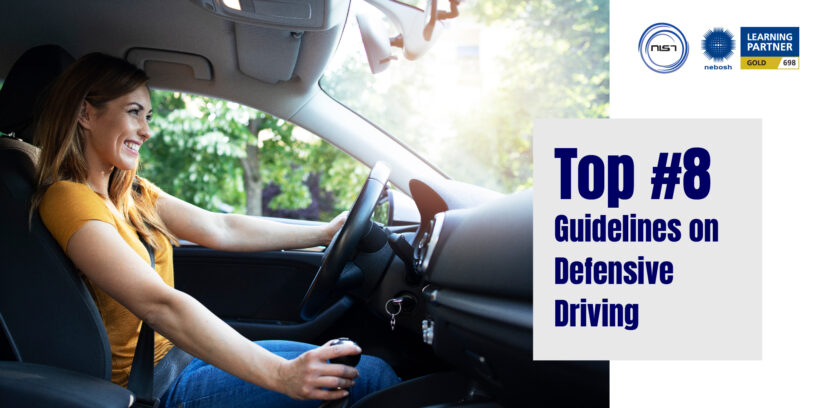No matter how much driving experience you have, you must always keep in mind that defensive driving techniques are the best way to drive safe. In all driving scenarios, it will always be advantageous to drive defensively. Being conscious of your surroundings has the potential to help you drive safely.
So who is a defensive driver? A driver who is extremely careful and conscious of his or her surroundings; the person who consistently plans ahead and becomes ready to manage worst-case events in the most effective manner.
Simple Guidelines for a Defensive Driver
Are you looking for advice on how to drive defensively for the safety of other road users and yourself?
Use the driving tips listed below to develop your defensive driving skills. It will not only teach you defensive driving, but it will also lower your chance of getting into an accident.
#1 Scan your Surroundings
One of the best practises to becoming a defensive driver is to scan your surroundings swiftly, efficiently, and precisely. You need to refine your Eye lead time through practise. According to safety regulations, an eye lead time for highway driving should not exceed 20 to 30 seconds, while it should be kept at a minimum of 12 to 15 seconds only when driving in cities. The dense metropolitan traffic, the rapid moving vehicles, and the increased likelihood of collisions are the causes of the shorter time.
You can foresee potential risks on the road ahead if you have a good eye lead time. With enough time, you can prepare your safe manoeuvre to reduce the likelihood of driving dangers.
#2 Maintain a Safe Distance from other vehicles
With the vehicle going ahead, the chances of an accident are doubled. So, what are your options? The answer is simple: maintain a safe following distance. The distance must not be less than 3-4 seconds in length. These seconds will be plenty to allow you to pause and come to a smooth rolling stop. Hard braking might result in significant physical harm.
Whether you are driving on motorways, highways, country roads, or city streets, remember to maintain a safe cushion distance from vehicles travelling ahead, behind, or sides. It is recommended to increase the distance in rainy, stormy, foggy, and snowy conditions.
#3 Trust your driving skills
Here, let’s focus on two key elements.
First, have trust in your ability to drive and that you will make wise choices. On the road, confusion can lead to chaos. Second, always put your own needs before those of others. You must take care of your own safety before you can protect others. Putting your safety first does not imply that the driver should drive hysterically selfishly. You need to show consideration for other drivers. But, always design a safe driving pattern anticipating that the other motorist will not be concerned to go safe.
#4 Improved Visibility
Driving is prohibited if vision is a problem. Depending on the conditions, there are several techniques to increase visibility. Maintain the windscreen, mirrors, and windows clean. Repair any headlights that are broken or damaged right away. There is no place for risk-taking. When it’s foggy outside, use a defogger and fog headlights. Don’t forget to properly defrost the ice when it’s snowing.
#5 Clear Communication
The cornerstone of safe driving is clear communication. You should always be clear about your intentions and let other drivers know what your next move will be, whether you are using hand signals or exterior lights. Communication that is clear and effective will help prevent issues. For instance, maintain eye contact, ensure that everyone can see your hand signal, always use indicators, and never forget to activate emergency lights if you have any.
#6 Beware of Blind Spots
When a driver claims that he was unable to predict the collision because the car appeared out of his blind spot, the both are at fault. Mirrors are installed for a reason, and it is best to use them on whenever required. Although every car has a blind spot, the rear-view, passenger, and driver’s side mirrors play a vital part in informing you about your surroundings. Make the most of the circumstance by using your peripheral vision and planning a safe move.
#7 Be cautious at intersections
Without a doubt, junctions are a high-risk zone since they bring together a large number of vehicles travelling in opposite directions. Although traffic signals direct vehicles when to turn or stop, red-light runners can create havoc. It is always safe to use the defensive technique and slow your vehicle at the intersection so that you can make an easy stop if required.
#8 Be Aware
Driving necessitates awareness. To drive safely, you must always be aware of your surroundings. Although awareness and eye lead time are somewhat comparable, we may claim that awareness goes beyond simple road scanning in anticipation. Being aware is being aware of everything going on in your immediate surroundings, which vehicle is in front of or behind you. Awareness is another name of attention and focus.
Observe all traffic lights. Pay close attention to any road signs. Pay close attention to every little thing, such as pedestrians, cyclists, and even animals. Avoid being side-tracked and keep your eyes straight ahead on the road. Use your mirrors to keep an eye out for any unexpected vehicles and be prepared to handle any driving situation.
NIST Global offers Defensive Driving Training
At NIST Global, we offer Defensive Driving Training for corporates, industries, etc., whose workforce may require to upskill their driving skills in order to prevent any accident or injury. Defensive driving training helps delegates comprehend traffic regulations, safe driving techniques, and essential vehicle mechanics. The major goals of the online defensive driving course are to lower risk by foreseeing potentially dangerous situations, unfavourable weather conditions, and driving blunders. In addition to helping the driver drive safely, defensive driving lowers the risk and impact of auto accidents. Drivers employed by businesses, factories, or other workplaces will find the defensive driving certification to be useful.
For further details about Defensive Driving Training, kindly contact our client servicing team @ +91 8754465588 / info@nistglobal.com














Leave a Reply